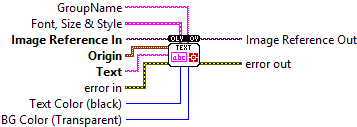OverlayText
OpenLvVision_Overlays.lvlib:OverlayText.vi
Overlays an text on top of an image.

| error in error in can accept error information wired from VIs previously called. Use this information to decide if any functionality should be bypassed in the event of errors from other VIs. Right-click the error in control on the front panel and select Explain Error or Explain Warning from the shortcut menu for more information about the error. |
| status status is TRUE (X) if an error occurred or FALSE (checkmark) to indicate a warning or that no error occurred. Right-click the error in control on the front panel and select Explain Error or Explain Warning from the shortcut menu for more information about the error. |
| code |
| source source describes the origin of the error or warning. Right-click the error in control on the front panel and select Explain Error or Explain Warning from the shortcut menu for more information about the error. |
| Image Reference In An Image reference is a handle to the actual image data in memory. It's important to note that you are responsible for manually releasing (deallocating) the memory associated with this image reference when it's no longer needed to prevent memory leaks. |
| GroupName Name of the overlay group you want to add to. |
| Origin |
| X |
| Y |
| Text |
| Text Color (black) Text Color (black) is the color of the text. |
| BG Color (Transparent) BG Color (Transparent) is the background color of the text overlay. |
| Font, Size & Style Font, Size & Style is a cluster that enables the user to choose the font, size, style, and alignment of the text. |
| Desired Font (Application) Desired Font (Application) specifies the character type of the text. |
| [User-specified Font] [User-specified Font] is a cluster containing the specific font characteristics for the text to draw. |
| Font Name Font Name is the font to use for the string. |
| Size Size is the size of the font in points. |
| Strikeout? Strikeout? causes the text to appear in strikeout if TRUE. |
| Italic? Italic? causes the text to appear in italic if TRUE. |
| Underline? Underline? causes the text to appear underlined if TRUE. |
| Outline? Outline? causes the text to appear in outline if TRUE. |
| Shadow? Shadow? causes the text to appear in shadow if TRUE. |
| Bold? Bold? causes the text to appear in bold if TRUE |
| Rotation Angle Rotation Angle is the orientation of the text in the image. NI Vision supports rotated text for TrueType fonts only. |
| Horizontal Alignment Horizontal Alignment specifies the horizontal alignment of the text. |
| Vertical Alignment Vertical Alignment specifies the vertical alignment of the text. |
| error out error in can accept error information wired from VIs previously called. Use this information to decide if any functionality should be bypassed in the event of errors from other VIs. Right-click the error in control on the front panel and select Explain Error or Explain Warning from the shortcut menu for more information about the error. |
| status status is TRUE (X) if an error occurred or FALSE (checkmark) to indicate a warning or that no error occurred. Right-click the error in control on the front panel and select Explain Error or Explain Warning from the shortcut menu for more information about the error. |
| code |
| source source describes the origin of the error or warning. Right-click the error in control on the front panel and select Explain Error or Explain Warning from the shortcut menu for more information about the error. |
| Image Reference Out An Image reference is a handle to the actual image data in memory. It's important to note that you are responsible for manually releasing (deallocating) the memory associated with this image reference when it's no longer needed to prevent memory leaks. |















